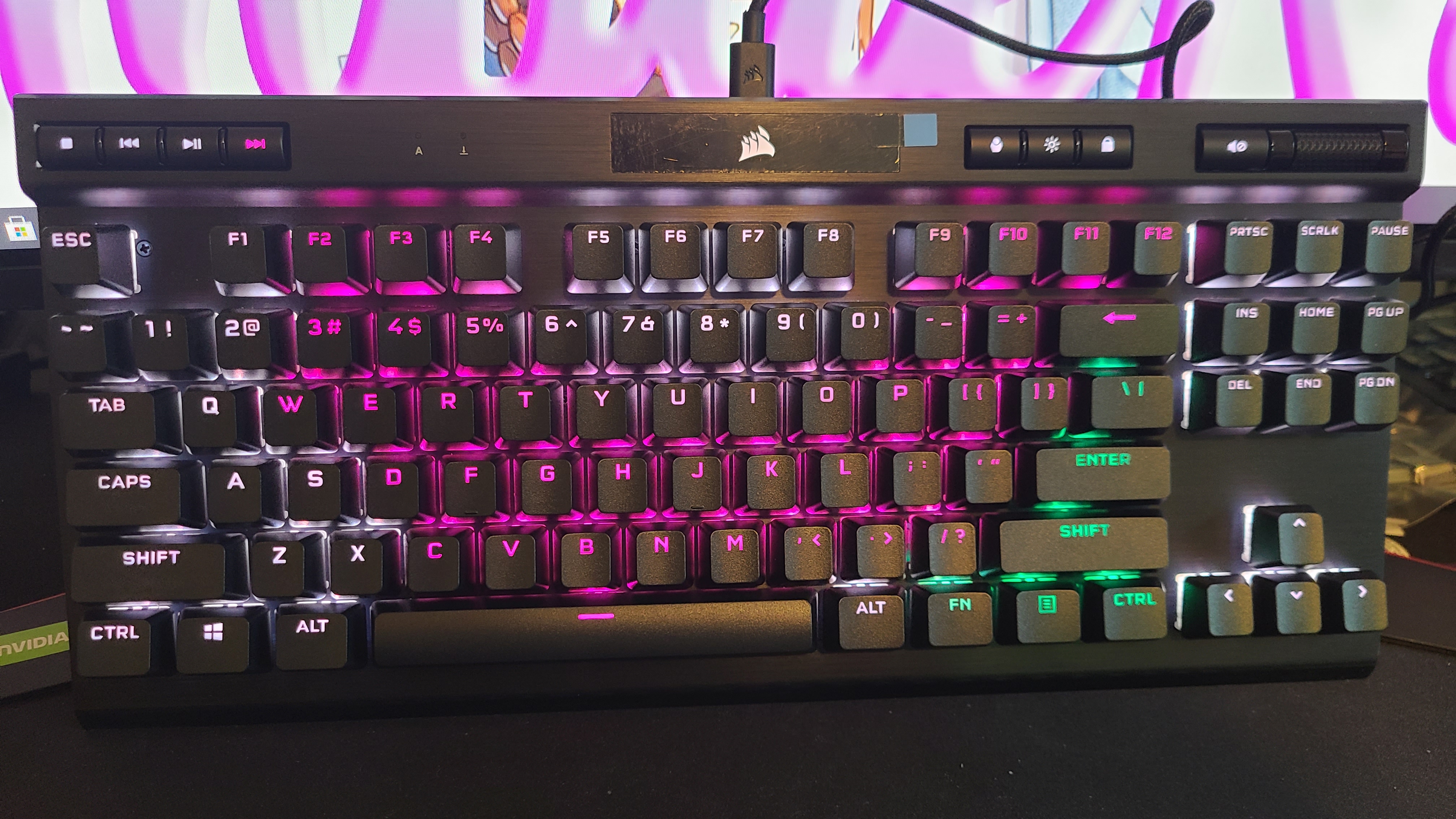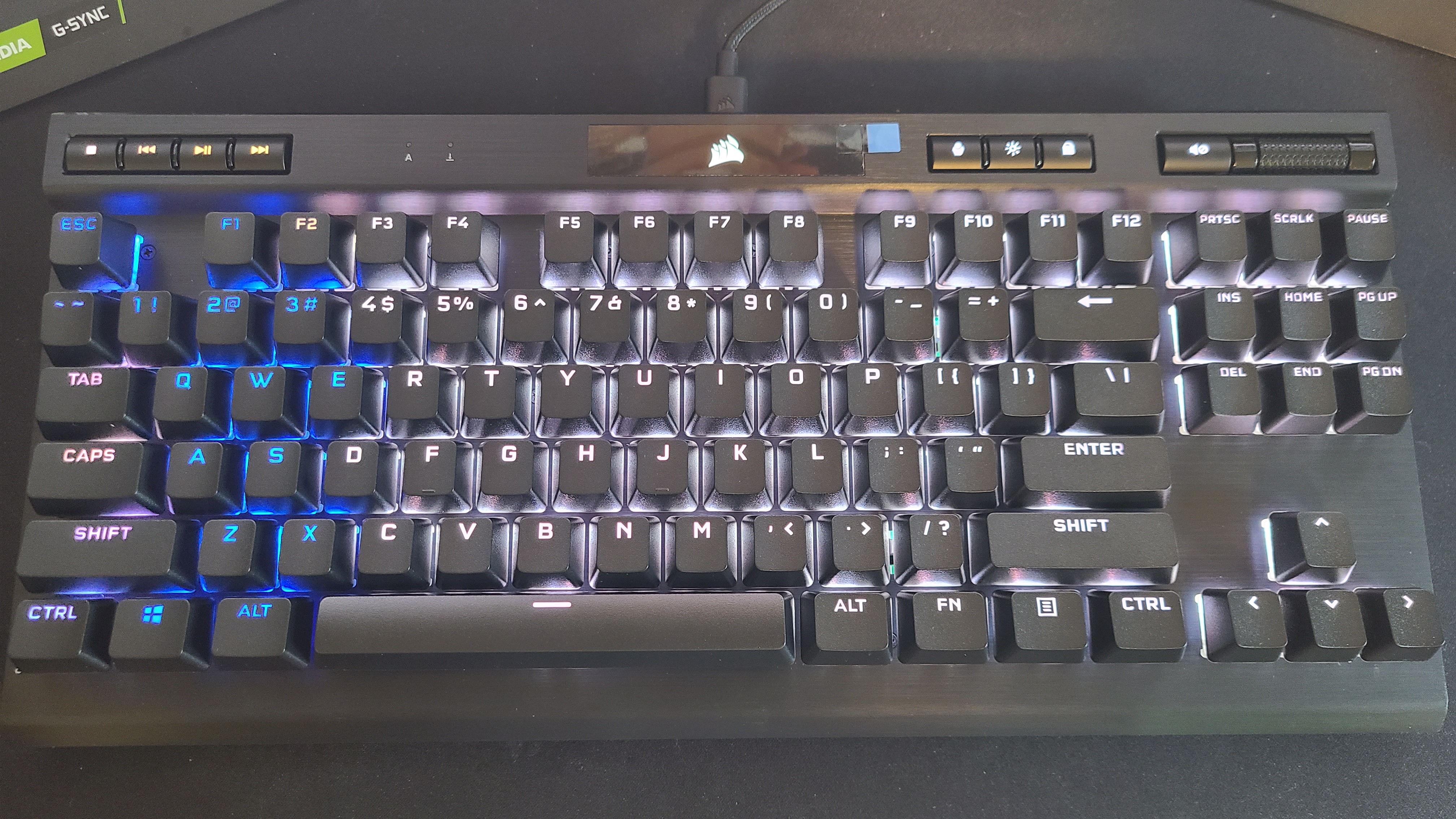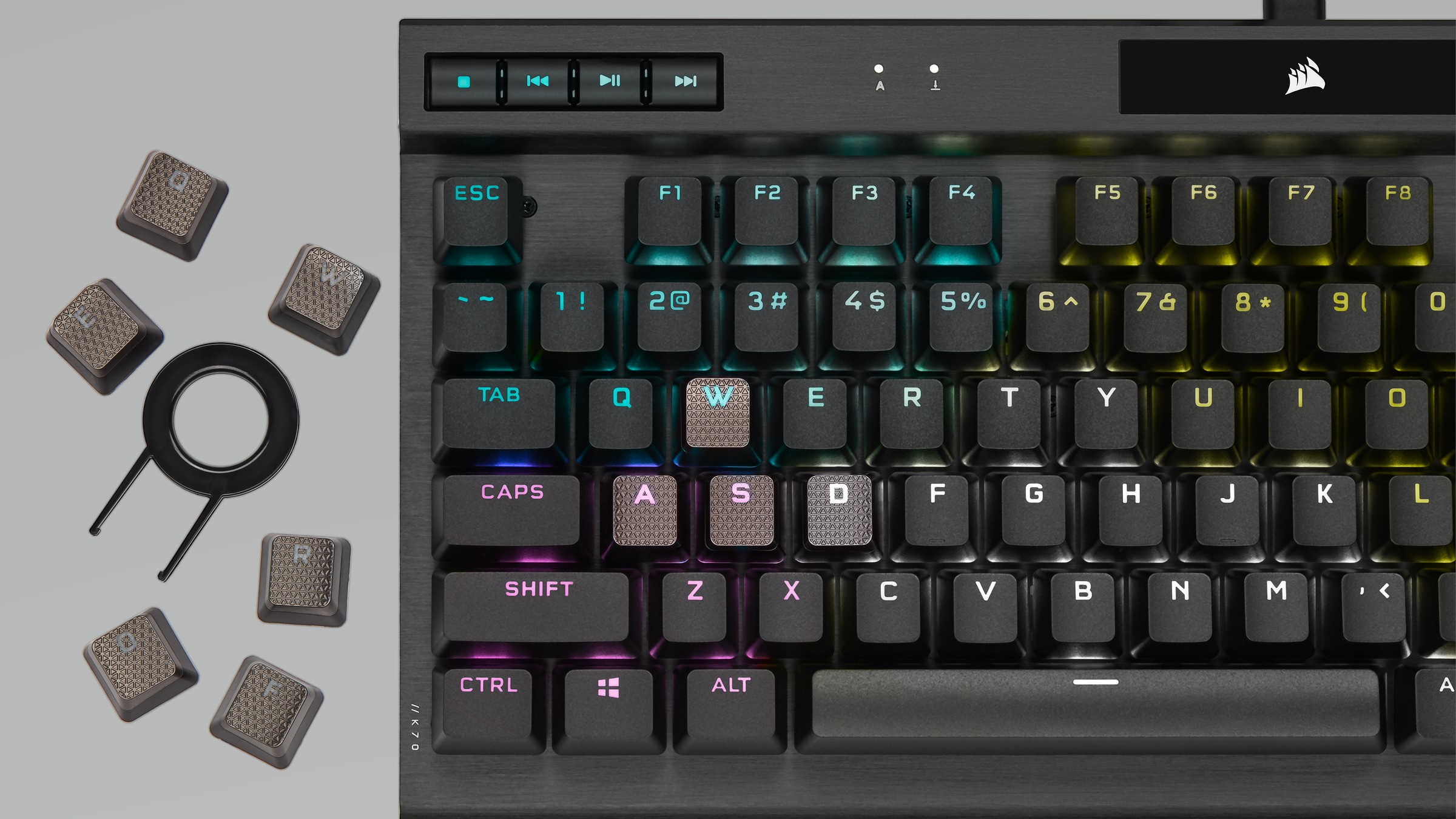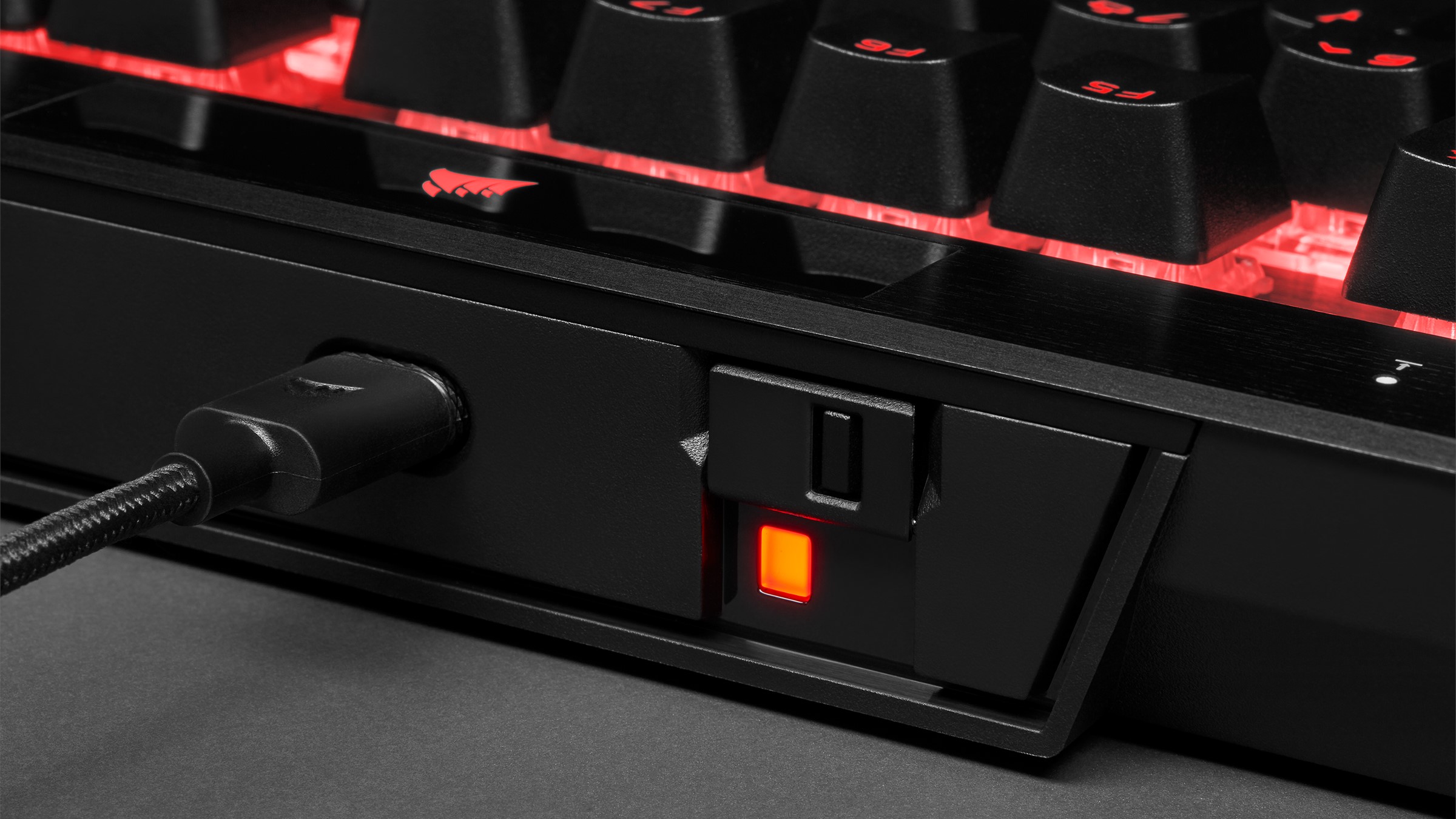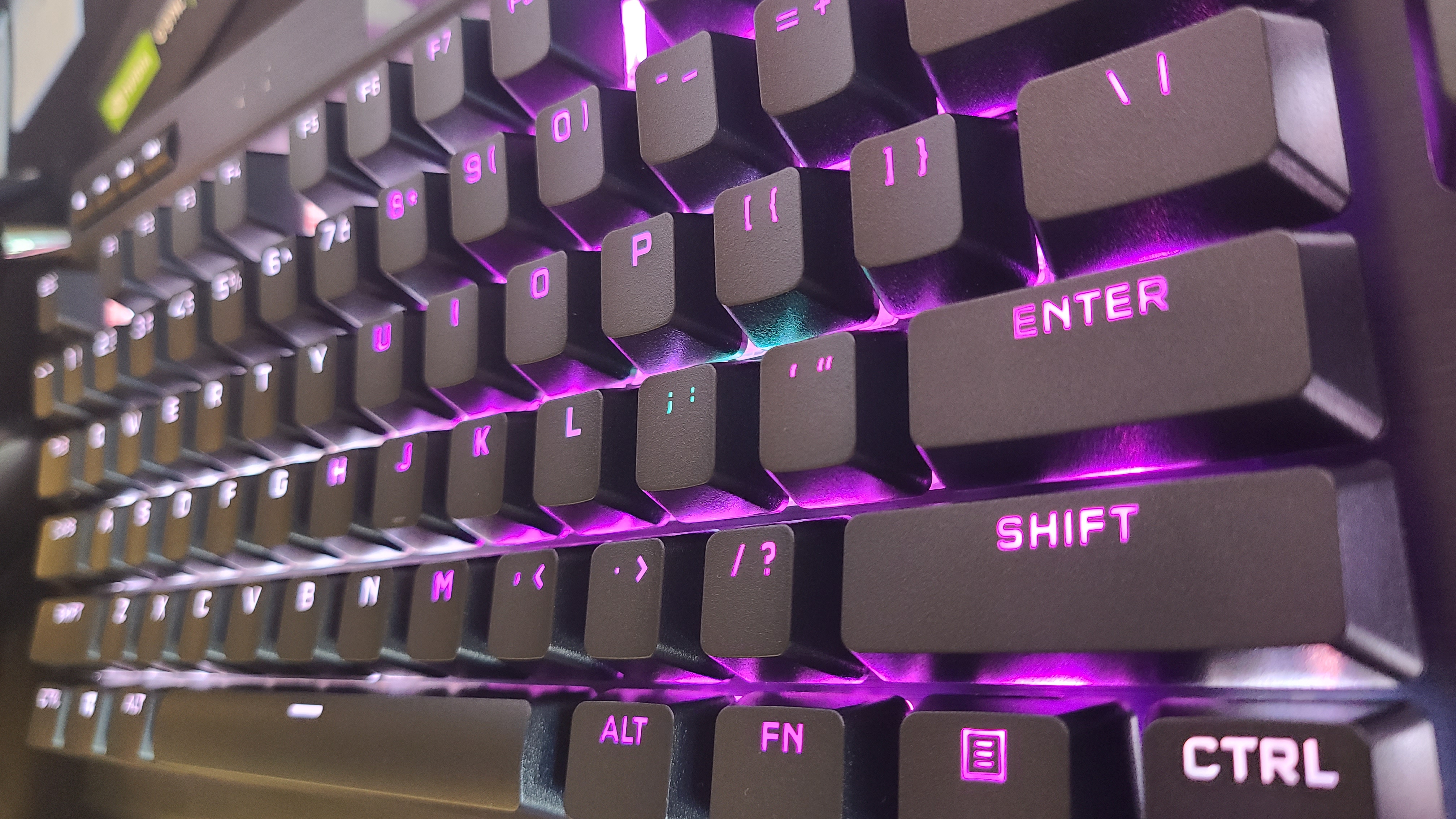Tom's Hardware Verdict
The Corsair K70 RGB TKL is a powerful yet compact gaming keyboard. We didn’t notice an immediate benefit from the 8,000 Hz polling rate, but with a sleek look plyus premium media controls and keycaps, this keyboard’s in a league of its own.
Pros
- +
+ Space-saving, durable build
- +
+ Premium keycaps
- +
+ Media keys
- +
+ Some software-free RGB control
Cons
- -
Close keys can require getting used to
- -
Expensive
Why you can trust Tom's Hardware
Let’s be real: Mechanical keyboards can get expensive. While the best budget mechanical keyboards can give you the switches you need, the best gaming keyboards often come with extra bells and whistles that up the price. At $140, the Corsair K70 RGB TKL is one example, but you get a lot for that price.
Corsair's been dubbing keyboards "K70" for a while. Just look at our Corsair K70 RGB Red review from 2016 or the most recent iteration, the low-profile Corsair K70 RGB MK.2. Our review focus brings the tenkeyless (TKL) form factor to the lineup.
The K70 RGB TKL is a competitive board that earns its price with extra features, like programmable keys, per-key RGB via manageable software. And as someone who games full-time, the quality of the keyboard’s build seems like a great investment. This is a sturdy keyboard that should hold up over extended use. And since this is a TKL keyboard, you’ll have all the space you need on your desk for your mouse, to let you focus exclusively on playing.
On top of that, Corsair is continuing its trend of upping the polling rate of its gaming keyboards, with the K70 RGB TKL offering an 8,000 Hz polling rate -- 8 times the 1,000 Hz you usually see. The usefulness of that high spec, however, is debatable.
Corsair K70 RGB TKL Specs
| Switches | Cherry MX Red (tested), Cherry MX Silent Red or Cherry MX Speed Silver |
| Lighting | Per-key RGB |
| Onboard Storage | 8MB |
| Media Keys | Yes |
| Interface | USB Type-A |
| Cable | 6 feet (1.8m) USB-C to USB-A , braided, detachable |
| Additional Ports | None |
| Keycaps | Doubleshot PBT plastic |
| Software | Corsair iCue |
| Dimensions (LxWxH) | 14.2 x 6.5 x 1.9 inches |
| Weight | 2.1 pounds |
| Extra | 1x ABS plastic A, S, D, Q, E and R keycaps, 2x ABS plastic W and D keycaps, 1x keycap puller |
Design
The Corsair K70 RGB TKL Champion Series is a tournament-ready keyboard with a colorful and durable design in a small form factor. As a TKL keyboard, it forgoes the numpad in favor of more desk space, which makes it great for people who don’t have a lot of room on their desk or travel a lot. At 14.2 x 6.5 x 1.9 inches, the K70 RGB TKL is similar but slightly taller than other TKL keyboards, such as the Razer BlackWidow V3 Tenkeyless (14.3 x 6.1 x 1.6 inches) and more petite Roccat Vulcan TKL Pro (14.2 x 5.3 x 1.3 inches). Another downside for travel is the K70 RGB TKL’s weight. It’s 2.1 pounds compared to 1.9 pounds for the Razer and 1.5 pounds for the Roccat.
But part of that slightly larger design comes thanks to the K70 RGB TKL’s inclusion of luxurious media keys. There are five dedicated hotkeys, plus an aluminum, textured volume roller, which are all a decent accomplishment to include on a TKL.
All those keys felt pretty solid, especially compared to the cheap plastic alternatives available on lower-priced keyboards.
This brings us to the overall durability of the keyboard. The K70 RGB TKL feels more rigid and sturdy than the ~$250 Logitech G915 Lightspeed full-sized wireless gaming keyboard I often use, (which has an identical design to its TKL counterpart, the Logitech G915 TKL). The Logitech is conveniently lightweight (2.3 pounds) and thin (0.9 inches) but feels like it might break if dropped. Suddenly, the K70 RGB TKL’s $140 price tag starts to make more sense. The K70 RGB TKL lives in a plastic chassis with a black matte finish and aluminum frame.
Get Tom's Hardware's best news and in-depth reviews, straight to your inbox.
With its media key layout and brushed aluminum finish the K70 RGB TKL looks more interesting than a lot of other TKLs (looking at you, Razer BlackWidow V3 Tenkeyless). And it’s mature and subdued enough to go well with any setup. But I’m not wowed by its overall look; it’s not earning any style points from me at first. Out of the box, this appears to be a tool for competitive gamers, not a showy looker. You can add a little more flair, however, if you use the included silver W, A, S, D, Q, E, R, D or F keycaps. These keycaps are a cheaper ABS plastic than the doubleshot PBT that the keys come with by default, but do add more color to the design and a slight texturing that I like a lot.
For even more customization, you’ll have to rely on the K70 RGB TKL’s per-key RGB effects. You’ll need the software to create and play with different RGB effects. But you can also toggle through 10 different presets and control speed and direction using FN shortcuts. You can also create profiles in the iCue software with different RGB effects and store them in your onboard memory. When you toggle through profiles with the dedicated profile switch button, the RGB will change accordingly. As somebody who loves the variety of RGB settings on my keyboard, it is wonderful to be able to control these settings regardless of whether iCUE is running or not.
Next to the profile switch button are an RGB brightness key and Windows lock key as well. These and the media keys are also reprogrammable via iCue for ultimate customization.
Corsair didn’t skimp when it came to the keycaps. The use of doubleshot PBT plastic delivers a more premium feel than standard ABS plastic. And doubleshot means the legends will never fade. The keycaps feel strong at 1.5mm thick and have a matte coating that easily fought off grease and fingerprints during my testing. With many still working from home, you’d be hard-pressed to find someone who isn’t eating near their keyboard, so this feature is highly appealing.
The K70 RGB TKL uses a detachable USB-C to USB-A cable that’s high-quality braided. Some keyboard’s USB cables can feel thin or cheap, but this one should survive a good amount of bending and wear. Our review focus’ cable is 6-feet-long, which is standard among gaming keyboards but can still feel a little long in actual use, which is why I prefer one of the best wireless keyboards when possible.
Typing Experience on Corsair K70 RGB TKL
The Corsair K70 RGB TKL comes with either Cherry MX Speed Silver, Cherry MX Silent Red or Cherry MX Red switches. All three options actuate with 45g of force and are linear, a mechanical switch style that tends to be a favorite among gamers for its interruption-free travel. Our review unit came with Red switches, which are specced for 2.0mm pretravel and 4.0mm total travel. Those who want less travel, (perhaps, potentially, for more speed, may prefer the Speed Silver switches (1.9mm / 3.7mm) or even the quieter Silent Reds (1.2mm / 3.4mm).
Pressing keys on the K70 RGB TKL felt lovely and easy because it felt like the keys registered quickly. But there’s very little space between the keys which, in addition to the lighter actuation force of Cherry MX Reds, made typos more common. As such, the K70 RGB TKL may require a slight adjustment period in order to use it smoothly, but this wasn’t a huge concern, as I was eventually able to adapt.
The doubleshot PBT keycaps were also a boon, both for typing and gaming. The quality plastic was more comfortable than the keyboards on most other keyboards I’ve tried. My typing accuracy increased slightly but like I stated I used less pressure to type, which I believe made typing easier.
8,000 Hz Polling Rate
Initially kicked off with the 4,000 Hz Corsair K100 RGB last year, Corsair is continuing its polling rate race with the 8,000 Hz K70 RGB TKL. It’s launching alongside the Corsair Sabre RGB Pro gaming mouse, which also has an 8,000 Hz polling rate, showing a newfound dedication to Hz from the gaming brand.
Your keyboard (or other peripheral) polling rate tells you how many times per second the device sends data to your PC. Instead of doing so 1,000 times a second, like the vast majority of gaming keyboards, the K70 RGB TKL can do it 8,000 times per second. It achieves this through what Corsair calls Axon, “an embedded onboard system with Corsair’s purpose-engineered, real-time operating system" running on a system-on-chip (SoC) with multi-threading in order to “process multiple complex instructions in parallel.” Corsair claims Axon uses an advanced scheduling algorithm. There are some caveats though.
First, there are some requirements. You’ll need a USB 3.0 port and to download iCue software and change the polling rate (from 1,000 Hz) in order to use the 8,000 Hz polling rate. Corsair also noted in its reviewer’s guide that the keyboard “transits keystrokes to the PC up to 8x faster than standard” but can only “detect keypresses up to 4x faster than conventional gaming keyboards.” The vendor doesn’t get too specific in terms of system requirements for 8,000 Hz. A rep told us, “Keyboards send a lot less data, so 8,000 Hz has only a small added CPU usage impact” but added, “the more up-to-date the system is – the smoother the experience.”
But similarly to when we used the 4,000 Hz polling rate on the K100 RGB, I didn’t notice a difference when moving from 1,000 Hz on the K70 RGB TKL to 8,000 Hz, despite using a system running an AMD Ryzen 5950X CPU. There’s a bit of future-proofing here, and it wouldn’t hurt for a very competitive pro player to have this feature handy. But as a low-level competitive player, I didn’t notice my speed or accuracy increase in Fortnite or Destiny.
Gaming Experience on Corsair K70 RGB TKL
This is still a powerful gaming weapon though, as it feels incredibly responsive and fast on the battlefield (whether gaming at 1,000 Hz or 8,000 Hz). I used the K70 RGB TKL during intense Fortnite matches, as well as crucible matches in Destiny, and it didn't disappoint. The quick and easy actuation of the go-to Cherry MX Red switches honestly made me feel like I was able to better focus on gameplay without looking at my keyboard as often as I normally do.
The best part was how lightly I had to touch the keys for them to register. This really cut down on hand fatigue. When I play, I usually overpress buttons and can even be guilty of mashing (gasp!). On Corsair’s TKL, I quickly realized I didn’t need to press the keys nearly as hard. That really reduced hand pain, which I sometimes experience after several hours of gaming.
And while the tight spacing of the keys was a bit of a hindrance for general typing, this became helpful when gaming, as it meant my fingers had less distance to travel to input my next move. Meanwhile, the TKL form factor gave me a little more room to breathe with my mouse, and I found it easier to focus on the game than when using a full-sized keyboard. I have always been a fan of a larger build but now I am thinking compact is the way moving forward.
Those doubleshot PBT keycaps also came in handy in action. The premium plastic doesn’t get slick, including from sweaty hands. These keys managed to stay dry during high-pressure gaming.
Features and Software on Corsair K70 RGB TKL
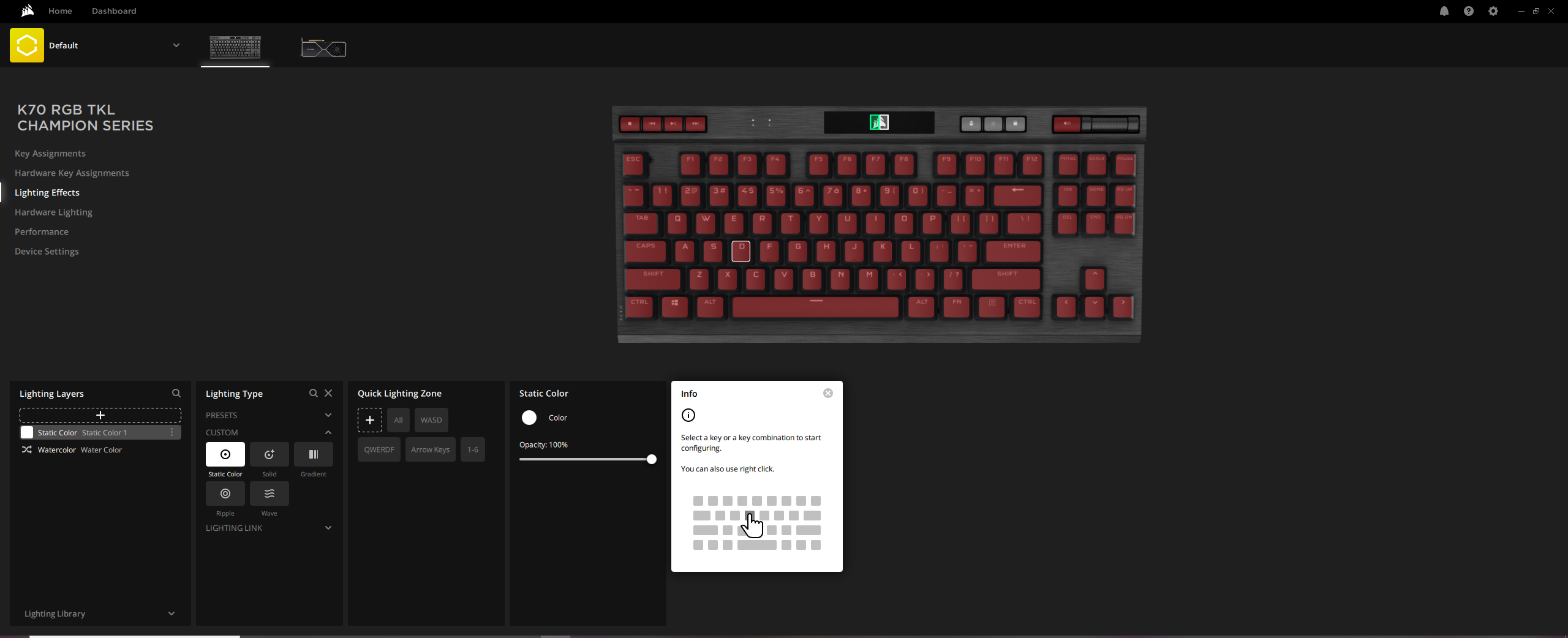
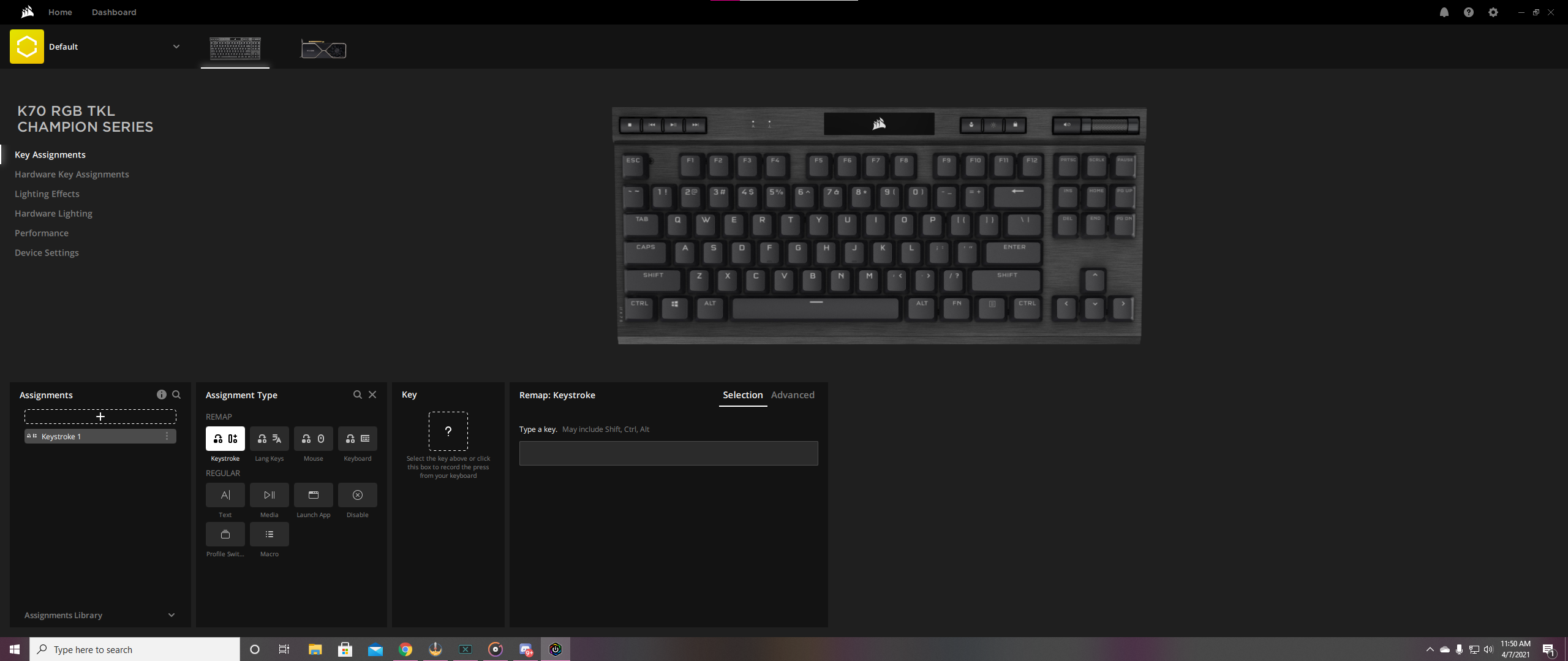
To create new RGB effects or make onboard or software-based profiles, you’ll need iCue, which I found user-friendly. The Corsair K70 RGB TKL features 8MB of onboard storage allowing you to customize to your heart’s content. You can store up to 50 onboard profiles, depending on the configuration, that allow you to customize your RGB settings with up to 20 lighting layers, as well as custom macros.
A unique feature, the keyboard also includes a Tournament Switch on the top edge. This could help you focus on your game more by swapping the keyboard to static backlighting to reduce distractions and disabling programmed actions / macros. As someone who’s been known to press incorrect buttons or clumsily drop things in the heat of battle, I found this to be a great addition.
Bottom Line
If you want a powerhouse of a keyboard made for competitive gameplay, the Corsair K70 RGB TKL is an immediate must-have. This keyboard isn’t just pleasant to look at, it is an efficient tool that will take your gameplay to the next level, thanks to responsive keys, high-end PBT keycaps and a lot of customization options both with or without software.
At $140, this is an expensive wired gaming keyboard though. For comparison, the HyperX Alloy Origins Core, one of the best budget mechanical keyboards, is about half the price, and the Razer BlackWidow V3 Tenkeyless is currently $100. But the K70 RGB Pro gives you a lot for the price. Not only is there a robust featureset, including media keys, this is a tough keyboard. I will definitely be utilizing it more for my tournament gaming needs. And there are pricier TKLs than the K70 RGB TKL, such as the $160 Roccat Vulcan TKL Pro with its optical-mechanical switches or the wireless Logitech G915 TKL, which starts at about $200 and is excellent but not for everyone, since it’s low-profile.
Ultimately, the K70 RGB TKL can be an efficient weapon in your gaming toolkit, granting you the look and functionality you need for your most competitive setup.
Known in the gaming community as Zombaekillz, Natasha Zinda is a professional content creator, a diversity advocate and an activist. You can find her stream on https://twitch.tv/zombaekillz or follow her on Twitter at @zombaekillz.
-
JamesSneed Its pretty obvious Ducky is the OEM of this board. Those keycaps look exactly like Ducky especially the number keys where the number and symbol are on the same row.Reply -
mortsmi7 I wish this came out last month when I was buying keyboards. But it doesn't look like they come with brown switches. And wow the prices have leaped again. I got a normal K70 RGB directly from corsair for $120 and this month they're up to $160.Reply -
Rexer Reply
Yeah, it does seem to have that, "I met you before, some time some place." kind of aesthetics. It's a trend manufacturers would rather do than have specialized R& D for products in their catalog. Probably to enlarge their product line, save money. Low overhead, high profits, etc., etc, blah, blah, blah.JamesSneed said:Its pretty obvious Ducky is the OEM of this board. Those keycaps look exactly like Ducky especially the number keys where the number and symbol are on the same row.
I bought a Havit KB 390L TKL a few years back with quick stroke keys and short flat switches. And now I notice several companies have employed the exact design.
I don't think it's bad thing. In fact, they're cheaper as the Havit 390 TKL has moved up in price by $30. Yeah, I sometimes I get in the sync of buying disposable products because it's better than paying an emperor's ransom for a name, high quality product for only a season. -
fmyhr Maybe instead of insane USB polling rates it's time to go back to PS/2 ports, with essentially zero latency. (Check out Wikipedia page...)Reply -
JamesSneed Replyfmyhr said:Maybe instead of insane USB polling rates it's time to go back to PS/2 ports, with essentially zero latency. (Check out Wikipedia page...)
Actually all you need is a USB to PS2 adapter and the polling rate is no more. However the keyboard must support PS2 and not all do these days.
